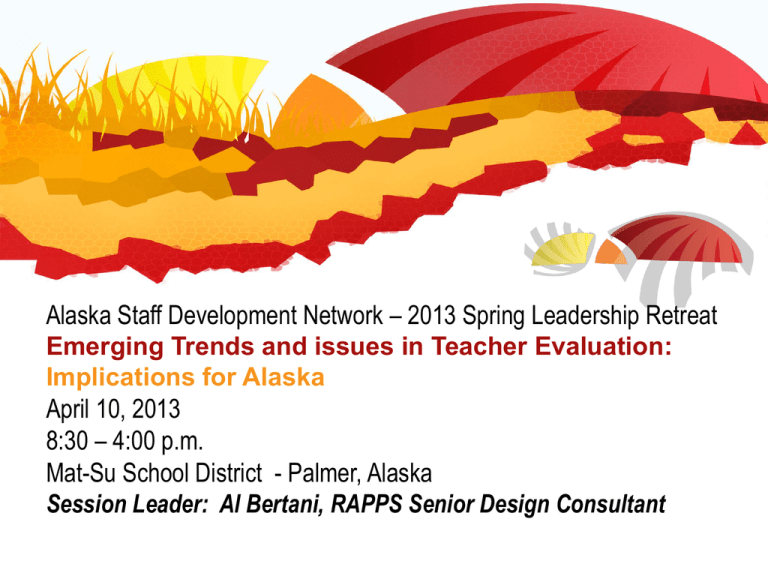leadership retreat ppt - Alaska Staff Development Network
advertisement

Alaska Staff Development Network – 2013 Spring Leadership Retreat Emerging Trends and issues in Teacher Evaluation: Implications for Alaska April 10, 2013 8:30 – 4:00 p.m. Mat-Su School District - Palmer, Alaska Session Leader: Al Bertani, RAPPS Senior Design Consultant Welcome Kelly Tonsmiere Director Alaska Staff Development Network Emerging Trends and Issues in Teacher Evaluation: Implications for Alaska ASDN Leadership Retreat; April 2013 Greetings Gene Stone Assistant Superintendent Matanuska-Sustina Borough School District Emerging Trends and Issues in Teacher Evaluation: Implications for Alaska ASDN Leadership Retreat; April 2013 Workshop Purposes and Agenda Overview Al Bertani RAPPS Senior Design Consultant Emerging Trends and Issues in Teacher Evaluation: Implications for Alaska ASDN Leadership Retreat; April 2013 Session Objectives 1. Examine the regulations and requirements of the recent Alaskan legislation regarding educator evaluations. 2. Explore learnings emerging from policy an procedural changes regarding educator evaluation across the U.S. 3. Understand how states and districts have organized their processes for revising educator evaluation systems. 4. Engage in a deep dive about different educator evaluation models. 5. Consider the implications of these trends and issues for Alaska districts while implementing the new State of Alaska policies and procedures for educator evaluations. Emerging Trends and Issues in Teacher Evaluation: Implications for Alaska ASDN Leadership Retreat; April 2013; Facilitated by Al Bertani, RAPPS Senior Design Consultant Session Design DESIGN FOR LEARNING MAINTAIN ENERGY CONNECT FRAME TASKS KEEP TIME PROMOTE ENGAGEMENT Session Norms 1. The LEARNING belongs to you, and it rests largely with you. 2. Enter into the discussions ENTHUSIASTICALLY!!! 3. Give FREELY of your experience, but don’t dominate the discussion. 4. CONFINE your discussions to the task assigned. 5. Say what you THINK… be honest! 6. Only ONE PERSON should talk at a time… avoid private conversations while someone else is talking… 7. Listen ATTENTIVELY to the presentations and discussions. 8. BE PATIENT with other participants… appreciate their point of view… 9. Be PROMPT and REGULAR in attendance. 10. Place your cell phones on SILENT or VIBRATE to minimize interruptions. Emerging Trends and Issues in Teacher Evaluation: Implications for Alaska ASDN Leadership Retreat; April 2013; Facilitated by Al Bertani, RAPPS Senior Design Consultant Framing the Day: Teacher Evaluation Trends and Issues Desired Outcomes 1. Help participants see their work in a larger context. 1. Connect local issues across district and state contexts. 1. Connect policy change with moral purpose for leaders. Emerging Trends and Issues in Teacher Evaluation: Implications for Alaska ASDN Leadership Retreat; April 2013; Facilitated by Al Bertani, RAPPS Senior Design Consultant The Widget Effect The Widget Effect: Our National Failure to Acknowledge and Act on Differences in Teacher Effectiveness; Weinberg, Saxton, Mulhelm, and Keeling; 2009 The Widget Effect ➔ Nearly all teachers received high ratings (good or great) ➔ Districts failed to recognize and reward excellence ➔ Professional development was rarely tied to results and when it was, little support was offered to teachers ➔ New teachers generally were rated above satisfactory, and tenure was seldom denied to teachers based on observation results ➔ Poor performance rarely led to teacher dismissal The Widget Effect: Our National Failure to Acknowledge and Act on Differences in Teacher Effectiveness; Weinberg, Saxton, Mulhelm, and Keeling; 2009 Evaluations That Help Teachers Learn “Before, I had no idea what my principal was looking for – I had to be a mind reader! So I just played it safe, taught a familiar lesson, one I knew would go well – but did the process improve my teaching?” Evaluations That Help Teachers Learn by Charlotte Danielson Educational Leadership – December 2010 ASCD The Evaluation Review SEE LINK BELOW TO YOUTUBE VIDEO http://www.youtube.com/watch?v=_p8cxmZLgsA Unprecedented Waves of Legislation 2010 to 2012 RTT and I3 Newly Elected Governors Legislative Majorities ➔ Mandated annual evaluations ➔ Use of student learning results ➔ Linking evaluation results to key personnel decisions (Tenure, RIF, Dismissal, Retention) Twenty-One States Represented in the Study: AZ, AR, CO, CT, DE, FL, ID, IL, IN, LA, MD, MI, MN, NV, NJ, NY, OH, OK, RI, TN, WA. Recent State Action on Teacher Effectiveness: What’s in State Law and Regulations Sara Mead; Bellwether Education Partners; August 2012 Evidence of Student Learning Required in Teacher Evaluation Systems All states in the study require the inclusion of some evidence of student learning… Ten (10) states - 50% of Evaluation Four (4) states - Less that 50% Four (4) states - Links highly effective ratings to threshold student learning gains Two (2) states - No prescribed percentage or threshold Recent State Action on Teacher Effectiveness: What’s in State Law and Regulations Sara Mead; Bellwether Education Partners; August 2012 “Parents, practitioners, and policy makers agree that the key to improving public education in America is placing highly skilled and effective teachers in all classrooms.” Evaluating Teacher Effectiveness How Teacher Performance Assessments Can Measure and Improve Teaching Linda Darling Hammond for the Center for American Progress October 2010 Teacher Evaluation Policy Issues 1. What is the frequency and timing of required evaluations? 2. Who is responsible for the development of the system? 3. What measures are required? 4. How is student growth factored in? 5. Is student achievement the preponderant criteria? 6. What are the evaluation categories? 7. Who is responsible for conducting evaluations? 8. What observation procedures are specified? 9. What are the required uses of evaluation results? 10. What employment consequences are tied to evaluations? State of the States: Trends and Early Lessons on Teacher Evaluation and Effectiveness Policies; National Council on Teacher Quality; October 2011 Top of Mind As you consider the focus of today’s Leadership Retreat and this Opening Session, what’s on your mind? As a table group, respond to these prompts: What are you excited about… What are you concerned about… Excited – Unlined Side of the Card Concerned – Lined Side of the Card EED Alaska Requirements for Educator Evaluations Susan McCauley, Director of Teaching and Learning - EED Sondra Meredith, Administrator Teacher Education and Certification - EED Desired Outcomes 1. Build clarity around legislative regulations and requirements. 1. Help leaders develop a greater comfort with the changes. 1. Minimize fears and anxieties. Emerging Trends and Issues in Teacher Evaluation: Implications for Alaska ASDN Leadership Retreat; April 2013; Facilitated by Al Bertani, RAPPS Senior Design Consultant Emerging Trends and Issues: Designing New Educator Evaluation Systems Desired Outcomes 1. Promote learning from early adopters. 1. Anticipate issues and concerns. 1. Develop readiness for building new systems. Emerging Trends and Issues in Teacher Evaluation: Implications for Alaska ASDN Leadership Retreat; April 2013; Facilitated by Al Bertani, RAPPS Senior Design Consultant A clear message has taken shape following Race to the Top, Investing in Innovation, and School Improvement Grants as part of the stimulus package… “ Federal policy now focuses on teacher ‘effectiveness’ rather than teacher ‘quality’.” Measuring Effectiveness: What Will It Take? By Stumbo and McWalters Educational Leadership – December 2010 ASCD Race to the Top The Race to the Top applications asked states to: “design and implement rigorous, transparent, and fair evaluation systems for teachers and principals that … differentiate effectiveness using multiple rating categories that take into account DATA ON STUDENT GROWTH AS A SIGNIFICANT FACTOR.” (Page 34 – Application Process) Measuring Effectiveness: What Will It Take? By Stumbo and McWalters Educational Leadership – December 2010 ASCD Blueprint for Reform The focus on teacher effectiveness is also reflected in the Blueprint for Reform in the ESEA Reauthorization… “We are calling on states and districts to develop and implement systems of teacher and principal evaluation and support and to identify effective and highly effective teachers and principals on the basis of student growth and other factors.” Measuring Effectiveness: What Will It Take? By Stumbo and McWalters Educational Leadership – December 2010 ASCD Different State Models for Evaluation Systems State Level Evaluation System Elective State-Level Evaluation System District Evaluation System With Required Parameters Standardized --------------------------------------------- More Flexible Strengths and Weakness of Elective Model Strengths The system allows for some local flexibility. Data collection can still be standardized for certain components. Districts can be directly compared in certain areas. Reliability is strong in required components. The system allows for continuance of locally developed models. Weaknesses Local flexibility in certain areas is diminished. The system presents more challenges for state oversight. Data aggregation of teacher results may be more difficult. A Practical Guide to Designing Comprehensive Teacher Evaluation Systems; National Comprehensive Center for Teacher Quality; May 2012 High Quality Teacher Evaluation Systems Possess these common characteristics… ➲ A consistent definition of good teaching ➲ A shared understanding of this definition ➲ Skilled evaluators Evaluations That Help Teachers Learn by Charlotte Danielson Educational Leadership – December 2010 ASCD Evaluations That Help Teachers Learn “Before, I had no idea what my principal was looking for – I had to be a mind reader! So I just played it safe, taught a familiar lesson, one I knew would go well – but did the process improve my teaching? Not at all! In my old school, the principal just came in with a checklist, but we never really talked. But this time, we had a great conversation about how to help my students want to write. It really made me think. As a result, I’ve got a new approach: I’m going to engage some students around the things they’re passionate about and have them try to convince their classmates about the value of such interests.” Evaluations That Help Teachers Learn by Charlotte Danielson Educational Leadership – December 2010 ASCD Teacher Evaluation Feedback SEE LINK BELOW TO YOUTUBE VIDEO http://www.youtube.com/watch?v=HFLpgWDrQ-E Evaluating Teachers – Three Ways ➤ Inputs are what a teacher brings to his or her position, generally measured as teacher background, beliefs, expectations, experience, pedagogical and content knowledge, certification and licensure, and educational attainment. ➤ Processes refers to the interaction that occurs in a classroom between teachers and students. It also may include a teacher’s professional activities within the larger school and community. ➤ Outputs represent the results of classroom processes, such as impact on student achievement, graduation rates, student behavior, engagement, attitudes, and social-emotional well-being. Approaches to Evaluating Teacher Effectiveness – June 2008 Goe, Bell, and Little National Comprehensive Center on Teacher Quality Evaluations That Help Teachers Learn A good system of teacher evaluation must answer four basic questions: How good is good enough? Good enough at what? How do we know? Who should decide? How well does your local teacher evaluation system answer these questions? Evaluations That Help Teachers Learn by Charlotte Danielson Educational Leadership – December 2010 ASCD Evaluations That Help Teachers Learn A good system of teacher evaluation must answer four basic questions: How good is good enough? Good enough at what? How do we know? Who should decide? How well does your local teacher evaluation system answer these questions? Evaluations That Help Teachers Learn by Charlotte Danielson Educational Leadership – December 2010 ASCD Comparing Teacher Evaluation Systems Examine examples of Teacher Evaluation Systems from Colorado, Tennessee, and Washington. Take your yellow packet and something to write with Form a trio with leaders from other tables. Decide who will read about each state – CO, TN, WA. Read quietly highlighting specific elements of the text. Be prepared to share your learnings with your colleagues. Use the Venn Diagram sheet to compare and contrast the elements of each example reviewed – CO, TN, WA. What’s the same – What’s different… You have the next fifteen minutes to complete your task. Emerging Trends and Issues in Teacher Evaluation: Implications for Alaska; ASDN Leadership Retreat; April 2013; Facilitated by Al Bertani, RAPPS Senior Design Consultant Comparing Teacher Evaluation Systems Colorado Tennessee Washington Emerging Trends and Issues in Teacher Evaluation: Implications for Alaska; ASDN Leadership Retreat; April 2013; Facilitated by Al Bertani, RAPPS Senior Design Consultant Research Study Questions Question 1 Can measures of effective teaching identify teachers who better help students learn? Question 2 How much weight should be placed on each measure of effective teaching? Question 3 How can teachers be assured trustworthy results from classroom observations? MET Project Ensuring Fair and Reliable Measures of Effective Teaching January 2013 Major Research Findings 1. Effective teaching can be measured. Teachers previously identified as more effective caused students to learn more. Groups of teachers identified as less effective caused students to learn less. 2. Balanced weights indicate multiple aspects of effective teaching. Teaching is too complex for any single measure of performance to capture it accurately. Trade off’s to using different models. 3. Adding a second observer increases reliability significantly more than having the same observer score an additional lesson. Adding outside observers can provide an on-going check against inschool bias. MET Project Ensuring Fair and Reliable Measures of Effective Teaching January 2013 Moving From and To… TODAY… FUTURE SCENARIO… High Level Principal Evaluations Only Rigorous Classroom Observations Input Observations Student Feedback Seniority Pedagogical Content Knowledge Degrees Earned School Working Conditions MET Working with Teachers to Develop Fair and Reliable Measures of Effective Teaching June 2010 Emerging Learnings: Trends and Issues: Implementing New Educator Evaluation Systems Desired Outcomes 1. Promote learning from implementation examples. 1. Help leaders understand how others have managed implementation issues. 1. Transfer learnings to local implementation efforts. Emerging Trends and Issues in Teacher Evaluation: Implications for Alaska ASDN Leadership Retreat; April 2013; Facilitated by Al Bertani, RAPPS Senior Design Consultant Evaluations That Help Teachers Learn A good system of teacher evaluation must answer four basic questions: How good is good enough? Good enough at what? How do we know? Who should decide? How well does your local teacher evaluation system answer these questions? Evaluations That Help Teachers Learn by Charlotte Danielson Educational Leadership – December 2010 ASCD Evaluations That Help Teachers Learn A good system of teacher evaluation must answer four basic questions: How good is good enough? Good enough at what? How do we know? Who should decide? How well does your local teacher evaluation system answer these questions? Evaluations That Help Teachers Learn by Charlotte Danielson Educational Leadership – December 2010 ASCD How Do We Know… Research Informed How would you weight the different aspects of effective teaching? Emerging Trends and Issues in Teacher Evaluation: Implications for Alaska ASDN Leadership Retreat; April 2013; Facilitated by Al Bertani, RAPPS Senior Design Consultant How Do We Know… Add lines and percentages for each component. Emerging Trends and Issues in Teacher Evaluation: Implications for Alaska ASDN Leadership Retreat; April 2013; Facilitated by Al Bertani, RAPPS Senior Design Consultant Good Enough at What – How Do We Know… School Leadership Professional Developmen t Classroom Observations Student Achievement Results Developed by Patrick Dolan and Al Bertani; Sample Teacher Evaluation Components; GE Foundation Conference; Orlando, Florida; June 2010 What Is Highly Effective… Classroom… School… District/Profession… Community-At-Large… Emerging Trends and Issues in Teacher Evaluation: Implications for Alaska ASDN Leadership Retreat; April 2013; Facilitated by Al Bertani, RAPPS Senior Design Consultant Good Enough at What… – How Do We Know… Working with your Table Group, identify what you think makes a teacher “highly effective” for each of the categories listed on the poster… Frame your responses as phrases and/or clauses. Consider your experiences as a teacher and leader. Think about the expectations of your school and district. Try to reach agreement on what should be recorded. Have the person wearing the most black serve as recorder. You have the next twelve minutes to complete your task. Emerging Trends and Issues in Teacher Evaluation: Implications for Alaska; ASDN Leadership Retreat; April 2013; Facilitated by Al Bertani, RAPPS Senior Design Consultant How Do We Know Examples… Examples from Denver, Hillsborough, Pittsburg, and Prince George’s County. Level 1 Items – Danielson’s Domains Level 2 Items – Danielson’s Components Level 3 Items – Danielson’s Elements Levels of Performance Source Unique Features Emerging Trends and Issues in Teacher Evaluation: Implications for Alaska; ASDN Leadership Retreat; April 2013; Facilitated by Al Bertani, RAPPS Senior Design Consultant The Danielson Framework Domain 1: Planning and Preparation •Demonstrating Knowledge of Content and Pedagogy •Demonstrating Knowledge of Students •Selecting Instructional Goals •Demonstrating Knowledge of Resources •Designing Coherent Instruction •Assessing Student Learning Domain 2: The Classroom Environment •Creating an Environment of Respect and Rapport •Establishing a Culture for Learning •Managing Classroom Procedures •Managing Student Behavior •Organizing Physical Space Domain 3: Instruction •Communicating Clearly and Accurately •Using Questioning and Discussion Techniques •Engaging Students in Learning •Providing Feedback to Students •Demonstrating Flexibility and Responsiveness Domain 4: Professional Responsibilities •Reflecting on Teaching •Maintaining Accurate Records •Communicating with Families •Contributing to the School and District •Growing and Developing Professionally •Showing Professionalism The Framework for Teaching Charlotte Danielson The Danielson Framework Example Elements Figure 6.7 DOMAIN 2: THE CLASSROOM ENVIRONMENT COMPONENT 2A: CREATING AN ENVIRONMENT OF RESPECT AND RAPPORT Elements: Teacher interaction with students Student interaction L E V E L ELEMENT UNSATISFACTORY O F P E R F O R M A N C E BASIC PROFICIENT DISTINGUISHED Teacher Teacher interaction with at least Interaction some students is negative, with Students demeaning, sarcastic, or inappropriate to the age or culture of the students. Students exhibit disrespect for teacher. Teacher-student interactions are generally appropriate but may reflect occasional inconsistencies, favoritism, or disregard for students’ cultures. Students exhibit only minimal respect for teacher. Teacher-student interactions are friendly and demonstrate general warmth, caring, and respect. Such interactions are appropriate to developmental and cultural norms. Students exhibit respect for teacher. Teacher demonstrates genuine caring and respect for individual students. Students exhibit respect for teacher as an individual, beyond that for the role. Student Interaction Students do not demonstrate negative behavior toward one another. Student interactions are generally polite and respectful. Students demonstrate genuine caring for one another as individuals and as students. Student interactions are characterized by conflict, sarcasm, or put-downs. The Framework for Teaching Charlotte Danielson Processing Tool – How Do We Know… Examples Notes Denver Public Schools Hillsborough County Public Schools Pittsburgh Public Schools Prince George’s County Public Schools Emerging Trends and Issues in Teacher Evaluation: Implications for Alaska ASDN Leadership Retreat; April 2013; Facilitated by Al Bertani, RAPPS Senior Design Consultant How Do We Know… Take your pink packet, blue sheet, and something to write with and form a quartet with leaders from other tables – Find a place to work in the room… ➽ Once you have your quartet - Count off by four. ➽ Each person will have a primary assignment to review. ➽ Take a few minutes to analyze your assigned reading. ➽ Use the advance organizer to take notes. ➽ Be prepared to discuss your findings with your colleagues. You have the next twelve minutes to complete your task. Emerging Trends and Issues in Teacher Evaluation: Implications for Alaska; ASDN Leadership Retreat; April 2013; Facilitated by Al Bertani, RAPPS Senior Design Consultant Deep Dive: Different Educator Evaluation Models Desired Outcomes 1. Provide multiple models for learning purposes. 1. Help leaders expand their mental models for educator evaluations. 1. Offer choice to meet individual learning needs. Emerging Trends and Issues in Teacher Evaluation: Implications for Alaska; ASDN Leadership Retreat; April 2013; Facilitated by Al Bertani, RAPPS Senior Design Consultant Deep Dive Break-Out Sessions Danielson’s Framework for Teaching – Main Room Steve Atwater, Superintendent Sean Dusek, Melissa Linton, and Tim Peterson Kenai Peninsula Borough School District Marzano’s iObservation Process - Room Sue Johnson, Coordinator of School Improvement, BSSD 5d+ Teacher Evaluation Rubric – Room Sandra Austin, University of Washington - Center for Educational Leadership Bill and Melinda Gates Foundation MET Project – Room Findings and Recommendations Al Bertani, Senior Design Consultant, RAPPS Project Emerging Trends and Issues in Teacher Evaluation: Implications for Alaska; ASDN Leadership Retreat; April 2013; Facilitated by Al Bertani, RAPPS Senior Design Consultant Local Implications: Designing and Implementing A New Educator Evaluation System Desired Outcomes 1. Engage in school or district level action planning. 1. Use reflection to consolidate learnings. 1. Help determine next steps. Emerging Trends and Issues in Teacher Evaluation: Implications for Alaska; ASDN Leadership Retreat; April 2013; Facilitated by Al Bertani, RAPPS Senior Design Consultant Designing Comprehensive Teacher Evaluation Systems Component Steps 1. Specifying evaluation system goals 2. Securing and sustaining stakeholder investment and cultivating a strategic communication plan 3. Selecting measures 4. Determining the structure of the evaluation system 5. Selecting and training evaluators 6. Ensuring data integrity and transparency 7. Using teacher evaluation results 8. Evaluating the system A Practical Guide to Designing Comprehensive Teacher Evaluation Systems; National Comprehensive Center for Teacher Quality; May 2012 Designing Comprehensive Teacher Evaluation Systems Evaluation System Goals Evaluating the System Stakeholder Investment Selecting Measures Using Results Structure of the System Data Integrity Preparing Evaluators A Practical Guide to Designing Comprehensive Teacher Evaluation Systems; National Comprehensive Center for Teacher Quality; May 2012 Evaluation System Goals What type of impact do you want the evaluation system to achieve? Will evaluation results be used for personnel and compensation decisions? Will supports be available for teachers in need? What human and financial resources are available? How will the teacher evaluation efforts affect other district initiatives? A Practical Guide to Designing Comprehensive Teacher Evaluation Systems; National Comprehensive Center for Teacher Quality; May 2012 Establishing Standards Are there existing standards that can be used to guide the development of a teacher evaluation system? Do the standards explicitly define desired teaching competencies? Have levels of teaching performance been established for the standards? Will the district move beyond improving student learning to define an effective teacher? Will evidence based teaching practices be a factor in identifying an effective teacher? A Practical Guide to Designing Comprehensive Teacher Evaluation Systems; National Comprehensive Center for Teacher Quality; May 2012 Stakeholder Involvement Who are the crucial stakeholders that need to be involved in designing the teacher evaluation system? What skills, experience, and knowledge do stakeholders bring to the table? Will the group have authority to make decisions or serve in an advisory capacity? Is there a communication plan including strategies to maintain communication throughout the process? How does the planning group seek feedback from others? A Practical Guide to Designing Comprehensive Teacher Evaluation Systems; National Comprehensive Center for Teacher Quality; May 2012 Selecting Measures ➩Do the measures match the goals and purposes of the evaluation? ➩Do the measures provide data on effective teacher practices and professional development needs? ➩Are the measures research-based? ➩Are the measures fair and accurate indicators? ➩Can the measures be implemented with limited human and financial resource capacity? A Practical Guide to Designing Comprehensive Teacher Evaluation Systems; National Comprehensive Center for Teacher Quality; May 2012 Selecting And Training Evaluators Who will be eligible to conduct evaluations? Will there be examples and explicit guidance in determining levels of proficiency and approval? To what extent will training provide opportunities for guided practice paired with specific feedback to improve reliability? Will evaluators be monitored regularly for reliability checks? How will implementation fidelity be ensured? A Practical Guide to Designing Comprehensive Teacher Evaluation Systems; National Comprehensive Center for Teacher Quality; May 2012 Green Sheet Planning and Implementation Template Goal: To design or implement a teacher evaluation system consistent with the EED Alaska Requirements concerning educator effectiveness. ACTION RESPONSIBILITY OUTCOME TIMELINE Emerging Trends and Issues in Teacher Evaluation: Implications for Alaska; ASDN Leadership Retreat; April 2013; Facilitated by Al Bertani, RAPPS Senior Design Consultant Teacher Evaluation 2.0 Report Recommendations 1. Should be annual - Every other year for "performing teachers”. 2. Should include clear and rigorous expectations based primarily on evidence of student learning. 3. Should consider multiple measures - classroom observations, teacher-generated tests, and district-wide assessments. 4. Should include rating scales based on four or five categories (ie. highly effective, effective, needs improvement, and ineffective). 5. Should provide regular feedback to teachers on their progress. 6. Should impact employment decisions based on the outcomes of evaluation. New Teacher Project; Teacher Evaluation 2.0 October 2010 Definition of Effective Teachers 1. Have high expectations for all students and help students learn, as measured by value-added or other test-based growth measures or by alternative measures. 2. Contribute to positive academic, attitudinal, and social outcomes for students such as regular attendance, on-time promotion to the next grade, on-time graduation, self-efficacy, and cooperative behavior. 3. Use diverse resources to plan and structure engaging learning opportunities; monitor student progress formatively; adapting instruction as needed; and evaluate learning using multiple sources of evidence. 4. Contribute to the development of classrooms and schools that value diversity and civic-mindedness. 5. Collaborate with other teachers, administrators, parents, and education professionals to ensure student success, particularly the success of students with special needs and those at high risk for failure. Approaches to Evaluating Teacher Effectiveness; Goe, Bell, and Little; National Comprehensive Center for Teacher Quality; June 2008 “One of the few areas of consensus among education policy makers, practitioners, and the general public today is that improving teacher quality is one of the most direct and promising strategies for improving public education outcomes in the United States especially for children who have historically been taught by the least qualified teachers.” Evaluating Teacher Effectiveness How Teacher Performance Assessments Can Measure and Improve Teaching Linda Darling Hammond for the Center for American Progress October 2010 An Alternative - Walk-Throughs… SEE LINK BELOW TO YOUTUBE VIDEO http://www.youtube.com/watch?v=yFX_Q8TQmRw Thank You for Your Participation If you would like additional information, please feel free to contact: Al Bertani, RAPPS Senior Design Leader 225 N. Columbus Drive – Suite 6808 Chicago, Illinois 60601 Phone: 312-505-1450 E-Mail: AlbertBertani@gmail.com








